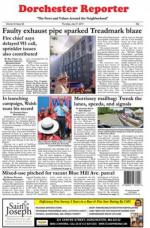July 23, 2008
The skirmish between federal and state highway authorities over the condition of the Longfellow Bridge- which has led to a 10 mile-per-hour speed restriction as crews check and rehabilitate the span over the Charles River - is not the only factor causing frustration for Red Line commuters in recent months.
A series of mishaps including disabled trains, disabled repair equipment, medical emergencies and bodies on the track have conspired to make the Red Line in June and July a more unpredictable commute than riders are accustomed to. Still, operations manager Anna Barry said she wasn't overly concerned this week.
"It's sad to say you go through some periods like that, where you have a lot of problems in a short period of time," said Barry. "There's nothing consistent we could be addressing."
According to the T's own performance indicators reports, and its T-Alert delay notification system, there have been fewer disabled trains than normal on the Red Line. The problem, said Barry, is that some incidents have been unusually difficult to deal with, such as the track-aligning equipment that malfunctioned on the Longfellow Bridge on July 15, forcing morning commuters traveling between 5 and 8 a.m. to take shuttles over the bridge and disrupting the train's normal schedule. The T has been replacing ties on the tracks across the bridge overnight and on weekends.
Adding to the chain of problems, a medical emergency at JFK/UMass Station held up trains during the evening rush hour on the day before that fiasco, and on the day after it, two disabled trains caused delays during the morning and rush hours.
In the last two months, people have also ended up on the tracks, at Davis Square in June and at Braintree in July, said Barry. And the end of May saw a cable fire that cleared two stations. This is all among a slew of more routine incidents.
Still, Barry said, it adds up to unfortunate coincidence. The T makes over 430 trips a day on the line between Somerville and Dorchester, and over recent years, the number of miles trains travel between breakdowns has actually increased on the Red Line, despite an aging fleet. Last month the MBTA Advisory Board approved a firm to begin engineering new cars for the Red and Orange Line that would be funded 80 percent by the federal government, and could begin arriving sometime in 2013.
"I'm confident that we're going to keep them running at a comfortable level of reliability on this line until they can be replaced," said Barry of the cars, around a third of which date to 1969. "It's a challenge, but it's the nature of what we do."
It's also the T's nature to put a good face on customer service, particularly when ridership is on the increase. Red Line rider numbers in May showed an increase of nearly 10 percent over the same month in 2007, according to the MBTA's count.
Though the older cars may be performing better each month due to stepped up maintenance, overhauls and component replacements, they are still well beyond what the T expected their service life to be - 30 years.
Hit earlier this year with retroactive pay raises for its employees and rapidly rising fuel costs, fed with a 1 percent sales tax that has had unexpectedly stagnant growth, and already strapped with a debt service that takes up around one quarter of its revenue, the T is not happy go lucky with the petty cash.
"The financial situation at the T is just as serious as it is at the Turnpike Authority," said MBTA Advisory Board president Paul Regan in a phone interview this week. "And the T has a growth in ridership There's too much debt, and costs that they can't control are going up. What the advisory board has been advocating is some sort of relief of debt."
Regan cited the aging Red Line fleet as another symptom of the state agency's financial malaise.
"The Red Line fleet is the oldest fleet," said MBTA advisory board chair Paul Regan. "We're getting past the point of routine maintenance."
According to the T's Capital Investment Plan (CIP), 74 of the 218 cars on the Red Line are part of the No. 1 Fleet, which was built in or before 1969. The normal life span of cars in the system, according to the same CIP, is 30 years. They are the oldest cars in the system outside of the World War II-era trolleys on the Ashmont-Mattapan line.
The good news is the advisory board recently approved a firm to engineer the cars, heralding the start of what could be an 11-year process, if all goes well.
Tags:



